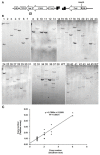High-Throughput and Accurate Determination of Transgene Copy Number and Zygosity in Transgenic Maize: From DNA Extraction to Data Analysis
- PMID: 34830369
- PMCID: PMC8619409
- DOI: 10.3390/ijms222212487
High-Throughput and Accurate Determination of Transgene Copy Number and Zygosity in Transgenic Maize: From DNA Extraction to Data Analysis
Abstract
It is vital to develop high-throughput methods to determine transgene copy numbers initially and zygosity during subsequent breeding. In this study, the target sequence of the previously reported endogenous reference gene hmg was analyzed using 633 maize inbred lines, and two SNPs were observed. These SNPs significantly increased the PCR efficiency, while the newly developed hmg gene assay (hmg-taq-F2/R2) excluding these SNPs reduced the efficiency into normal ranges. The TaqMan amplification efficiency of bar and hmg with newly developed primers was calculated as 0.993 and 1.000, respectively. The inter-assay coefficient of variation (CV) values for the bar and hmg genes varied from 1.18 to 2.94%. The copy numbers of the transgene bar using new TaqMan assays were identical to those using dPCR. Significantly, the precision of one repetition reached 96.7% of that of three repetitions of single-copy plants analyzed by simple random sampling, and the actual accuracy reached 95.8%, confirmed by T1 and T2 progeny. With the high-throughput DNA extraction and automated data analysis procedures developed in this study, nearly 2700 samples could be analyzed within eight hours by two persons. The combined results suggested that the new hmg gene assay developed here could be a universal maize reference gene system, and the new assay has high throughput and high accuracy for large-scale screening of maize varieties around the world.
Keywords: Southern blot; TaqMan assay; digital PCR; high throughput; maize endogenous reference gene; single-nucleotide polymorphism; transgene copy number; zygosity.
Conflict of interest statement
The authors declare no conflict of interest.
Figures



Similar articles
-
Quantitative real-time PCR assay for determining transgene copy number in transformed plants.Biotechniques. 2001 Jul;31(1):132-4, 136-40. doi: 10.2144/01311rr04. Biotechniques. 2001. PMID: 11464506
-
Comparison of droplet digital PCR with quantitative real-time PCR for determination of zygosity in transgenic maize.Transgenic Res. 2016 Dec;25(6):855-864. doi: 10.1007/s11248-016-9982-0. Epub 2016 Sep 8. Transgenic Res. 2016. PMID: 27632191
-
Accurate measurement of transgene copy number in crop plants using droplet digital PCR.Plant J. 2017 Jun;90(5):1014-1025. doi: 10.1111/tpj.13517. Epub 2017 Apr 11. Plant J. 2017. PMID: 28231382
-
Use of real-time PCR for determining copy number and zygosity in transgenic plants.Plant Cell Rep. 2004 Nov;23(5):263-71. doi: 10.1007/s00299-004-0859-y. Epub 2004 Sep 11. Plant Cell Rep. 2004. PMID: 15368076 Review.
-
Assessing zygosity in progeny of transgenic plants: current methods and perspectives.J Biol Methods. 2016 Jul 18;3(3):e46. doi: 10.14440/jbm.2016.114. eCollection 2016. J Biol Methods. 2016. PMID: 31453212 Free PMC article. Review.
References
-
- Mladenovic-Drinic S., Ignjatovic-Micic D., Eric I., Andjelkovic V., Jelovac D., Konstantinov K. Biotechnology in maize breeding. Genetika. 2004;36:93–109. doi: 10.2298/GENSR0402093M. - DOI
-
- James C. Global Status of Commercialized Biotech/GM Crops: 2019. ISAAA Brief 55: Executive Summary. [(accessed on 22 September 2021)]. Available online: http://www.isaaa.org/resources/publications/briefs/55/executivesummary/d....
-
- Zale J. Transgenic Plant Analysis. In: Stewart C.N. Jr., editor. Plant Biotechnology and Genetics. Wiley; Hoboken, NJ, USA: 2008. pp. 275–290.
-
- Meyer P. Stabilities and Instabilities in Transgene Expression. In: Lindsey K., editor. Transgenic Plant Research. Harwood Academic; Amsterdam, The Netherlands: 1998. pp. 263–275.
MeSH terms
Substances
Grants and funding
LinkOut - more resources
Full Text Sources
Other Literature Sources
Miscellaneous

